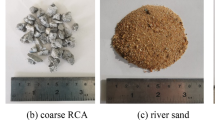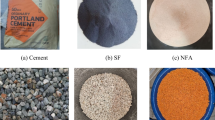Abstract
In general, all countries in the world use ordinary Portland cement concrete for the construction purpose; this ordinary Portland cement (OPC) gives good mechanical properties and durability to the buildings. The binder cement and the filler aggregate are the ingredients widely used in the process of concrete. Natural resources are used to extract both filler and binder elements. In India, the fast-growing sectors like infrastructure, smart cities development, and real estate consume concrete in large quantity. Also, India is the second largest cement manufacturer in the world. The need of cement is increasing day to day, even though the country is manufacturing the cement more than the required demand. In an average, the cement manufacturing industries produce 6% of CO2; for example, if industries produce 1 tonne of cement, they also emit 1 tonne of CO2. This brings us environment changes and produces more pollution to the country. To handle this situation, after many research, geopolymer concrete has been developed. Geopolymer concrete (GC) is all about mixing of source materials to the alkaline solution. Fly ash (FA) that is collected from the power plant is used in GC. The FA-based GC gives more strength when compared to the normal OPC concrete. Under ambient and steam curing, the compression, flexural strength, and tensile strength of FAGC and steel-reinforced geopolymer (SFGC) were tested and results were compared with normal concrete. FAGC mix proportions were studied under different ratios for sodium hydroxide and sodium silicate with 10 M. When compared with normal cement, the strength given by FAGC achieved good strength under ambient temperature. FAGC was further tested for the acid, sulfate, water absorption, and sorptivity test and compared with OPC concrete.










Similar content being viewed by others
Data availability
All the necessary data are given in the paper in detail.
References
Abhishek B, Chouhan RK, Manish M, Amritphale SS (2015) Fly ash based geopolymer concrete a new technology towards the greener environment: A review. Int J Innovative Res Sci Eng Technol 4(12):12178–12186
Azevedo ARG, Vieira CMF, Ferreira WM, Faria KCP, Pedroti LG, Mendes BC (2020) Potential use of ceramic waste as precursor in the geopolymerization reaction for the production of ceramic roof tiles. J Build Eng 29(May):101156. https://doi.org/10.1016/j.jobe.2019.101156
Bernal S, De Gutierrez R, Delvasto S, Rodriguez E (2010) Performance of an alkali-activated slag concrete reinforced with steel fibers. Constr Build Mater 24(2):208–214. https://doi.org/10.1016/j.conbuildmat.2007.10.027
Bhutta A, Borges PH, Zanotti C, Farooq M, Banthia N (2017) Flexural behavior of geopolymer composites reinforced with steel and polypropylene macro fibers. Cem Concr Compos 80(Jul):31–40. https://doi.org/10.1016/j.cemconcomp.2016.11.014
Chithra S, Kumar SS, Chinnaraju K, Ashmita FA (2016) A comparative study on the compressive strength prediction models for high performance concrete containing nano silica and copper slag using regression analysis and artificial neural networks. Constr Build Mater 114(Jul):528–535. https://doi.org/10.1016/j.conbuildmat.2016.03.214
De Silva P, Sagoe-Crenstil K, Sirivivatnanon V (2007) Kinetics of geopolymerization: Role of Al2O3 and SiO2. Cem Concr Res 37(4):512–518. https://doi.org/10.1016/j.cemconres.2007.01.003
Hardjito D, Rangan BV (2005) Development and properties of low calcium fly ash-based geopolymer concrete. Curtin Univ. of Technology, Perth, Australia
Hardjito D, Wallah SE (2002) Study on engineering properties of fly ash-based geopolymer concrete. J Aust Ceram Soc 38(1):44–47
Hardjito D, Wallah SE, Sumajouw DM, Rangan BV (2005) Fly ash-based geopolymer concrete. Aust J Struct Eng 6(1):77–86. https://doi.org/10.1080/13287982.2005.11464946
He P, Wang M, Fu S, Jia D, Yan S, Yuan J, Xu J, Wang P, Zhou Y (2016) Effects of Si/Al ratio on the structure and properties of metakaolin based geopolymer. Ceram Int 42(13):14416–14422. https://doi.org/10.1016/j.ceramint.2016.06.033
Islam A, Alengaram UJ, Jumaat MZ, Ghazali NB, Yusoff S, Bashar II (2017) Influence of steel fibers on the mechanical properties and impact resistance of lightweight geopolymer concrete. Constr Build Mater 152(Oct):964–977. https://doi.org/10.1016/j.conbuildmat.2017.06.092
Natarajan KS, Ramalingasekar D, Palanisamy S, Ashokan M (2022) Effect on mechanical properties of lightweight sustainable concrete with the use of waste coconut shell as replacement for coarse aggregate. Environ Sci Pollut Res 29(26):39421–39426. https://doi.org/10.1007/s11356-022-18905-9
KarthigaShenbagam N, Praveena R (2022) Performance of “Bacteria on Self-Healing Concrete and its Effects as Carrier.” Mater Today Proc. https://doi.org/10.1016/j.matpr.2022.05.322
Li W, Xu J (2009) Mechanical properties of basalt fiber reinforced geopolymeric concrete under impact loading. Mater Sci Eng A 505(1–2):178–186. https://doi.org/10.1016/j.msea.2008.11.063
Liu JC, Sue ML, Kou CH (2009) Estimating the strength of concrete using surface rebound value and design parameters of concrete material. Tamkang J Sci Eng 12(1):1–7
Mahendran K, Arunachelam N (2016) Performance of fly ash and copper slag based geopolymer concrete. Indian J Sci Technol 9(2):1–6. https://doi.org/10.17485/ijst/2016/v9i2/86359
Marín-López C, Araiza JR, Manzano-Ramírez A, Avalos JR, Perez-Bueno JJ, Muñiz-Villareal MS, Ventura-Ramos E, Vorobiev Y (2009) Synthesis and characterization of a concrete based on metakaolin geopolymer. Inorg Mater 45(12):1429. https://doi.org/10.1134/S0020168509120231
Mehta A, Siddique R (2018) Sustainable geopolymer concrete using ground granulated blast furnace slag and rice husk ash: Strength and permeability properties. J Clean Prod 205(Dec):49–57. https://doi.org/10.1016/j.jclepro.2018.08.313
Mithun BM, Narasimhan MC (2016) Performance of alkali activated slag concrete mixes incorporating copper slag as fine aggregate. J Clean Prod 112(Jan):837–844. https://doi.org/10.1016/j.jclepro.2015.06.026
Neethu SM, Usha S (2016) Effects of copper slag as partial replacement for fine aggregate in geopolymer concrete. In Proc., Int. Conf. on emerging trends in engineering and management. Peshawar, Pakistan: City Univ. of Science and Information Technology, 73–77
Paija N, Kolay PK, Mohanty M, Kumar S (2019) Ground bottom ash application for conventional mortar and geopolymer paste. J Hazard Toxic Radioact Waste 24(1):04019025. https://doi.org/10.1061/(ASCE)HZ.2153-5515.0000466
Sarker PK, McBeath S (2015) Fire endurance of steel reinforced fly ash geopolymer concrete elements. Construction and Building Materials 90:91–98
Sarker PK (2011) Bond strength of reinforcing steel embedded in fly ash-based geopolymer concrete. Mater Struct 44:1021–1030
Nath P, Sarker PK, Rangan VB (2015) Early age properties of low-calcium fly ash geopolymer concrete suitable for ambient curing. Procedia Eng 125:601–607
Raman SN, Ngo T, Mendis P, Mahmud HB (2011) High-strength rice husk ash concrete incorporating quarry dust as a partial substitute for sand. Constr Build Mater 25(7):3123–3130. https://doi.org/10.1016/j.conbuildmat.2010.12.026
Rangan BV (2008) Fly ash-based geopolymer concrete. Curtin Univ. of Technology, Perth, Australia
Salih MA, Farzadnia N, Ali AAA, Demirboga R (2015) Development of high strength alkali activated binder using palm oil fuel ash and GGBS at ambient temperature. Constr Build Mater 93(Sep):289–300. https://doi.org/10.1016/j.conbuildmat.2015.05.119
Salihoglu NK, Salihoglu G (2018) Marble sludge recycling by using geopolymerization technology. J Hazard Toxic Radioact Waste 22(4):04018019. https://doi.org/10.1061/(ASCE)HZ.2153-5515.0000415
Sarker PK (2011) Bond strength of reinforcing steel embedded in fly ash-based geopolymer concrete. Mater Struct 44(5):1021–1030. https://doi.org/10.1617/s11527-010-9683-8
Singh B, Ishwarya G, Gupta M, Bhattacharyya SK (2015a) Geopolymer concrete: A review of some recent developments. Constr Build Mater 85:78–90
Singh G, Das S, Ahmed AA, Saha S, Karmakar S (2015b) Study of granulated blast furnace slag as fine aggregates in concrete for sustainable infrastructure. Procedia Social Behav Sci 195(Jul):2272–2279. https://doi.org/10.1016/j.sbspro.2015b.06.316
Sreenivasulu C, Ramakrishnaiah A, Jawahar JG (2015) Mechanical properties of geopolymer concrete using granite slurry as sand replacement. Int J Adv Eng Technol 8(2):83–91
Sreenivasulu C, Jadaprolu GJ, Chundupalli S (2018a) Study and predicting the stress-strain characteristics of geopolymer concrete under compression. Case Stud Constr Mater 8(Feb):172–192. https://doi.org/10.1016/j.cscm.2018a.01.010
Sreenivasulu C, Jawahar JG, Sashidhar C (2018b) Predicting compressive strength of geopolymer concrete using NDT techniques. Asian J Civ Eng 19(4):513–525. https://doi.org/10.1007/s42107-018-0036-1
Sreenivasulu C, Guru JJ, Sekhar RMV, Pavan KD (2016) Effect of fine aggregate blending on short-term mechanical properties of geopolymer concrete. Asian J Civ Eng 17(5):537–550
Author information
Authors and Affiliations
Contributions
Karthiga Shenbagam Natarajan, have equally contributed for this work.
Corresponding author
Ethics declarations
Ethics approval
This is the work done by me and it is not published anywhere else by us.
Consent to participate
All the authors of this paper have given their consent to participate and act as one of the authors.
Consent for publication
I, the author, give my consent for the publication of identifiable details, which can include photograph(s) or case history and details within the text
Competing interests
The authors declare no competing interests.
Additional information
Responsible Editor: Philippe Garrigues
Publisher's note
Springer Nature remains neutral with regard to jurisdictional claims in published maps and institutional affiliations.
Supplementary Information
Below is the link to the electronic supplementary material.
Rights and permissions
Springer Nature or its licensor holds exclusive rights to this article under a publishing agreement with the author(s) or other rightsholder(s); author self-archiving of the accepted manuscript version of this article is solely governed by the terms of such publishing agreement and applicable law.
About this article
Cite this article
Natarajan, K.S., Yacinth, S.I.B. & Veerasamy, K. Strength and durability characteristics of steel fiber-reinforced geopolymer concrete with addition of waste materials. Environ Sci Pollut Res 30, 99026–99035 (2023). https://doi.org/10.1007/s11356-022-22360-x
Received:
Accepted:
Published:
Issue Date:
DOI: https://doi.org/10.1007/s11356-022-22360-x




